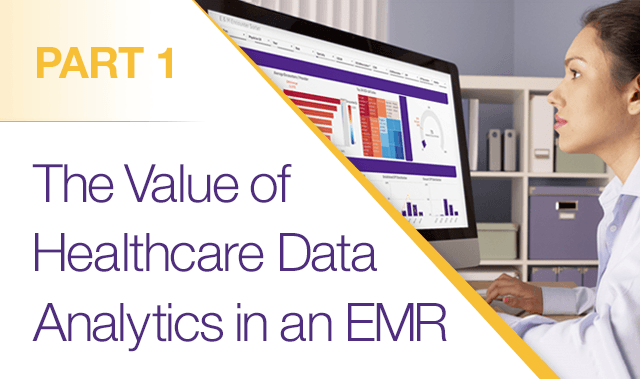Part 1: The Value of Healthcare Data Analytics in an EMR

Data and analytics. We base many decisions on data and reviewing analytics. When it comes to the medical field, data is crucial especially as the industry transitions to value-based care. You want to ensure your electronic medical record (EMR) system can capture such data, but more importantly give it back to you in visible and easy-to-digest snippets that you can slice and dice. Visibility into your EMR data can help you improve the clinical, operational and financial outcomes of your practice.
Erin Dettrey Senior Product Manager at Modernizing Medicine outlines how you can execute a data analytics strategy and the importance of having such a strategy in place. In reading the following post you will gain insight into the pieces of analytics, why they matter to your practice and how Modernizing Medicine’s suite of solutions, including Analytics, can help you transform the clinical, operational and financial aspects of your practice.
In this blog series and webinar about EMR systems and Analytics, Erin will cover:
- Pillars of a strong data strategy
- Current options and those that are coming in Modernizing Medicine’s Analytics platform
- The ability to take large amounts of raw data, Excel worksheets and data tables and how to turn them into analytics that can enable strong decision-making
- Some use cases involving compliance, population health analytics, identification of revenue gaps and audit risks
- Upcoming trends and future data needs
The Three Pillars for a Healthcare Data Analytics Strategy
So what are the components of a strong data analytics strategy for your dermatology practice?
We’re going to look at the data strategy in three pillars, talk about the components and how to avoid getting lost in the mix.
1. Minding the Orchards (aka Your Data). When I look at the practice landscape, and we’re talking about the entire practice as a whole, I like to use the analogy of a huge set of orchards. Sometimes, you need to take a step back to see all facets of your orchard. The blueberry and pumpkin patches can be symbolic of your different office locations and different service lines.
As the manager of this orchard, you need to be able to look at it globally and understand the different pieces at a very macro level. You also need to narrow down, for example, to the apple orchard and be able to look at a specific tree and understand the pros and cons of what’s going on with that tree down to a specific branch, and then down into a specific apple. The ability to look from the wide-scale view to the micro view is the first pillar. This allows you to take a very global look at your entire ecosystem and drill all the way through the location to the provider down to the patient level. So minding the orchards, or your practice, is data pillar number one.
2. Having a Complete Data Set. You need to attempt to leverage a complete data set, so the more vendors you have at the table, the more you segment practice management, EMR, pathology and any ancillary services, and the more challenging it is to get a complete data vision. As we look ahead to the future, Modernizing Medicine will provide a complete data experience across all the different products. Pillar number two includes working as much as possible with complete data sets from across the entire organization. A complete data set should be comprised of claims data, provider-driven data, patient-driven data and operational data.
3. Delivery and Avoiding the Data Island. Delivery is key because you need to avoid the data island. I’m going to give you a scenario that may sound familiar. Have you scratched your head and asked yourself, “I wonder if the waiting room time impacts a patient-reported outcome?” If we think about the steps necessary to get this data, you’re going to need to dig through your dermatology practice management system to look for waiting room times. You’re going to need to dig through your dermatology EMR system to connect those to patient-reported outcomes. And on top of that, you’re probably going to ask your IT staff and maybe even your data team for an Excel worksheet. Once you have that Excel worksheet, you’re most likely the only one that can access it. And you’re not finished there. Then, you have to create a fancy chart or a table and present this data and then, guess what, the next question comes up. “I wonder if patient waiting time is impacted by day of the week or time of day or the check-in staff?” This is the problem with having a very detailed delivery pathway that includes multiple data sets going through one IT administrator. You end up with a data island where you get to one answer that only you have. You have to repeat this pathway each time to answer the next set of questions.
You would have to dig further into your practice management and EMR systems and work with IT to start answering the questions. It’s easier to look at data in a combined fashion and give it to your executive team, including mid-level managers, who can use it to collaborate and help make patient flow, patient experience, patient outcomes, efficiency and the financial pieces of your practice work well. However, the reality is data tends to live a bit on an island and is only available to select individuals in the organization.
As a company, we took this data quandary along with the three pillars to help guide our data analytics strategy via Modernizing Medicine’s Analytics platform. In two upcoming posts, I’ll dive into some of the challenges you may face when it comes to Analytics, discuss solutions and what’s ahead.